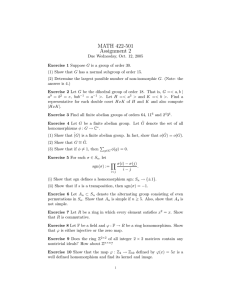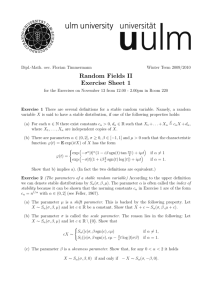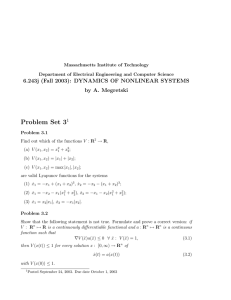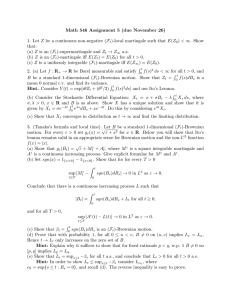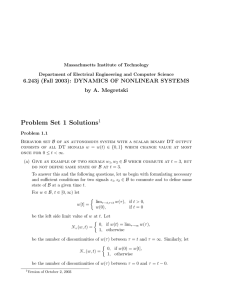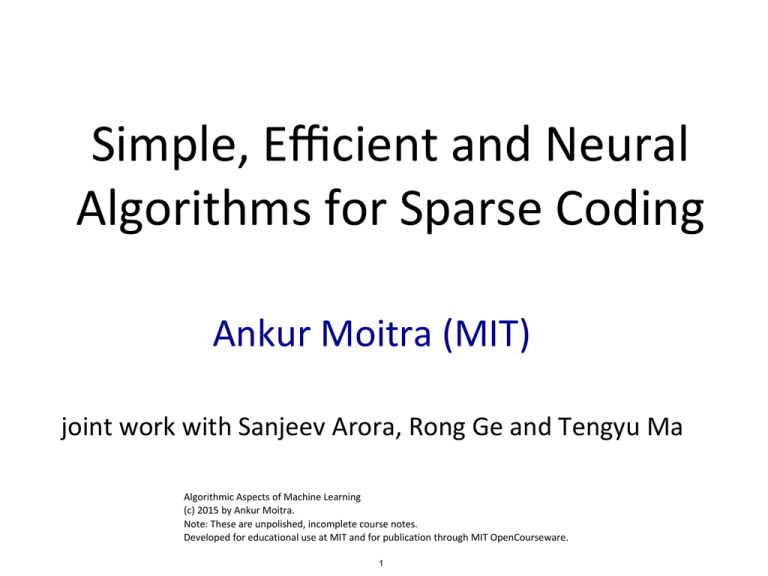
Simple, Efficient and Neural Algorithms for Sparse Coding Ankur Moitra (MIT) joint work with Sanjeev Arora, Rong Ge and Tengyu Ma Algorithmic Aspects of Machine Learning
(c) 2015 by Ankur Moitra.
Note: These are unpolished, incomplete course notes.
Developed for educational use at MIT and for publication through MIT OpenCourseware.
1
B. A. Olshausen, D. J. Field. “Emergence of simple-­‐cell recepNve field properNes by learning a sparse code for natural images”, 1996 break natural images into patches: sparse coding © Nature. All rights reserved. This content is
excluded from our Creative Commons license.
For more information, see http://ocw.mit.edu/
help/faq-fair-use/.
(collecNon of vectors) 2
Proper2es: localized, bandpass and oriented
B. A. Olshausen, D. J. Field. “Emergence of simple-­‐cell recepNve field properNes by learning a sparse code for natural images”, 1996 break natural images into patches: singular value decomposi2on (collecNon of vectors) 3
Noisy! Difficult to interpret! OUTLINE Are there efficient, neural algorithms for sparse coding with provable guarantees? Part I: The Olshausen-­‐Field Update Rule A Non-­‐convex FormulaNon Neural ImplementaNon A GeneraNve Model; Prior Work Part II: A New Update Rule Online, Local and Hebbian with Provable Guarantees ConnecNons to Approximate Gradient Descent Further Extensions 4
More generally, many types of data are sparse in an appropriately chosen basis: at most k non-­‐zeros dicNonary (n × m) A Sparse Coding/ Dic2onary Learning: Can we learn A from examples? ≈ … x … (i)
representaNons (m × p) … b … (i)
e.g. images, signals,… data (n × p) NONCONVEX FORMULATIONS Usual approach, minimize reconstruc2on error: p min A, x(i)’s i = 1 p b(i) -­‐ A x(i) + L(x(i)) i = 1 non-­‐linear penalty func2on (encourage sparsity) This opNmizaNon problem is NP-­‐hard, can have many local opNma; but heuris2cs work well nevertheless… 6
A NEURAL IMPLEMENTATION [Olshausen, Field]: xi output L’(xi) – dicNonary stored as synapse weights residual image (sNmulus) + + + + … – + Ai,j – rj + bj – + … – + A NEURAL IMPLEMENTATION [Olshausen, Field]: output dicNonary stored as synapse weights residual image (sNmulus) bj A NEURAL IMPLEMENTATION [Olshausen, Field]: output dicNonary stored as synapse weights residual image (sNmulus) rj + + bj + + A NEURAL IMPLEMENTATION [Olshausen, Field]: output + + + + dicNonary stored as synapse weights residual image (sNmulus) Ai,j rj + + bj + + A NEURAL IMPLEMENTATION [Olshausen, Field]: xi output + + + + dicNonary stored as synapse weights residual image (sNmulus) Ai,j rj + + bj + + A NEURAL IMPLEMENTATION [Olshausen, Field]: L’(xi) output – dicNonary stored as synapse weights residual image (sNmulus) – Ai,j rj – – – This network performs gradient descent on: b -­‐ A x 2 + L(x) by alternaNng between (1) r b – Ax Δ (2) x x + η(ATr – L(x)) Moreover A is updated through Hebbian rules There are no provable guarantees, but works well But why should gradient descent on a non-­‐convex funcNon work? Are simple, local and Hebbian rules sufficient to find globally opNmal soluNons? 13
OTHER APPROACHES, AND APPLICATIONS Signal Processing/Sta2s2cs (MOD, kSVD): De-­‐noising, edge-­‐detecNon, super-­‐resoluNon Block compression for images/video Machine Learning (LBRN06, …): Sparsity as a regularizer to prevent over-­‐fimng Learned sparse reps. play a key role in deep-­‐learning Theore2cal Computer Science (SWW13, AGM14, AAJNT14): New algorithms with provable guarantees, in a natural genera2ve model 14
Genera2ve Model: unknown dicNonary A
generate x with support of size k u.a.r., choose non-­‐zero values independently, observe b = Ax [Spielman, Wang, Wright ‘13]: works for full coln rank A up to sparsity roughly n½ (hence m ≤ n) [Arora, Ge, Moitra ‘14]: works for overcomplete, μ-­‐incoherent A up to sparsity roughly n½-­‐ε/μ [Agarwal et al. ‘14]: works for overcomplete, μ-­‐incoherent A up to sparsity roughly n¼/μ, via alternaNng minimizaNon [Barak, Kelner, Steurer ‘14]: works for overcomplete A up to sparsity roughly n1-­‐ε, but running Nme is exponen2al in accuracy 15
OUR RESULTS Suppose k ≤ √n/μ polylog(n) and |A| ≤ √n polylog(n) Suppose A that is column-­‐wise δ-­‐close to A for δ ≤ 1/polylog(n) Theorem [Arora, Ge, Ma, Moitra ‘14]: There is a variant of the OF-­‐update rule that converges to the true dicNonary at a geometric rate, and uses a polynomial number of samples All previous algorithms had subopNmal sparsity, worked in less generality, or were exponen2al in a natural parameter Note: k ≤ √n/2μ is a barrier, even for sparse recovery i.e. if k > √n/2μ, then x is not necessarily the sparsest soln to Ax = b 16
OUTLINE Are there efficient, neural algorithms for sparse coding with provable guarantees? Part I: The Olshausen-­‐Field Update Rule A Non-­‐convex FormulaNon Neural ImplementaNon A GeneraNve Model; Prior Work Part II: A New Update Rule Online, Local and Hebbian with Provable Guarantees ConnecNons to Approximate Gradient Descent Further Extensions 17
A NEW UPDATE RULE Alternate between the following steps (size q batches): (1) x(i) = threshold(ATb(i)) q (2) A A + η (b(i) – Ax(i))sgn(x(i))T i = 1 18
A NEW UPDATE RULE Alternate between the following steps (size q batches): (1) x(i) = threshold(ATb(i)) (zero out small entries) q (2) A A + η (b(i) – Ax(i))sgn(x(i))T i = 1 19
A NEW UPDATE RULE Alternate between the following steps (size q batches): (1) x(i) = threshold(ATb(i)) q (2) A A + η (b(i) – Ax(i))sgn(x(i))T i = 1 The samples arrive online 20
A NEW UPDATE RULE Alternate between the following steps (size q batches): (1) x(i) = threshold(ATb(i)) q (2) A A + η (b(i) – Ax(i))sgn(x(i))T i = 1 The samples arrive online In contrast, previous (provable) algorithms might need to compute a new esNmate from scratch, when new samples arrive 21
A NEW UPDATE RULE Alternate between the following steps (size q batches): (1) x(i) = threshold(ATb(i)) q (2) A A + η (b(i) – Ax(i))sgn(x(i))T i = 1 22
A NEW UPDATE RULE Alternate between the following steps (size q batches): (1) x(i) = threshold(ATb(i)) q (2) A A + η (b(i) – Ax(i))sgn(x(i))T i = 1 The computaNon is local 23
A NEW UPDATE RULE Alternate between the following steps (size q batches): (1) x(i) = threshold(ATb(i)) q (2) A A + η (b(i) – Ax(i))sgn(x(i))T i = 1 The computaNon is local In parNcular, the output is a thresholded, weighted sum of acNvaNons 24
A NEW UPDATE RULE Alternate between the following steps (size q batches): (1) x(i) = threshold(ATb(i)) q (2) A A + η (b(i) – Ax(i))sgn(x(i))T i = 1 25
A NEW UPDATE RULE Alternate between the following steps (size q batches): (1) x(i) = threshold(ATb(i)) q (2) A A + η (b(i) – Ax(i))sgn(x(i))T i = 1 The update rule is explicitly Hebbian 26
A NEW UPDATE RULE Alternate between the following steps (size q batches): (1) x(i) = threshold(ATb(i)) q (2) A A + η (b(i) – Ax(i))sgn(x(i))T i = 1 The update rule is explicitly Hebbian “neurons that fire together, wire together” 27
A NEW UPDATE RULE Alternate between the following steps (size q batches): (1) x(i) = threshold(ATb(i)) q (2) A A + η (b(i) – Ax(i))sgn(x(i))T i = 1 The update rule is explicitly Hebbian 28
A NEW UPDATE RULE Alternate between the following steps (size q batches): (1) x(i) = threshold(ATb(i)) q (2) A A + η (b(i) – Ax(i))sgn(x(i))T i = 1 The update rule is explicitly Hebbian The update to a weight Ai,j is the product of the acNvaNons at the residual layer and the decoding layer 29
WHAT IS NEURALLY PLAUSIBLE, ANYWAYS? Our update rule (essenNally) inherits a neural implementaNon from [Olshausen, Field] However there are many compeNng theories for what consNtutes a plausible neural implementaNon e.g. nonnegaNve outputs, no bidirecNonal links, etc… But ours is online, local and Hebbian, all of which are basic properNes to require The surprise is that such simple building blocks can find globally op2mal soluNons to highly non-­‐trivial algorithmic problems! 30
APPROXIMATE GRADIENT DESCENT We give a general framework for designing and analyzing iteraNve algorithms for sparse coding The usual approach is to think of them as trying to minimize a non-­‐convex funcNon: min E(A, X) = B -­‐ A X A, coln-­‐sparse X 31
2 F APPROXIMATE GRADIENT DESCENT We give a general framework for designing and analyzing iteraNve algorithms for sparse coding The usual approach is to think of them as trying to minimize a non-­‐convex funcNon: min E(A, X) = B -­‐ A X 2 F A, coln-­‐sparse X colns are b(i)’s 32
colns are x(i)’s APPROXIMATE GRADIENT DESCENT We give a general framework for designing and analyzing iteraNve algorithms for sparse coding How about thinking of them as trying to minimize an unknown, convex funcNon? min E(A, X) = B -­‐ A X A 2 F Now the funcNon is strongly convex, and has a global opNmum that can be reached by gradient descent! New Goal: Prove that (with high probability) the step (2) approximates the gradient of this funcNon 33
CONDITIONS FOR CONVERGENCE Consider the following general setup: op2mal solu2on: z* update: zs+1 = zs – η gs Defini2on: gs is (α, β, εs)-­‐correlated with z* if for all s: gs,zs-­‐z* ≥ α 2 s
*
z -­‐z + β 2 s
g -­‐ εs Theorem: If gs is (α, β, εs)-­‐correlated with z*, then 2 s
*
z -­‐z ≤ (1-­‐2αη)s 2 0
*
z -­‐z + maxs εs α This follows immediately from the usual proof… 34
(1) x(i) = threshold(ATb(i)) Decoding Lemma: If A is 1/polylog(n)-­‐close to A and A – A ≤ 2, then decoding recovers the signs correctly (whp) (2) A A + η q (b(i) – Ax(i))sgn(x(i))T i =1 Key Lemma: ExpectaNon of (the column-­‐wise) update rule is A j A j + ξ (I -­‐ A j ATj )A j + ξ ER [A R AR T]A j + error A j -­‐ A j systemic bias where R = supp(x)\j, if decoding recovers the correct signs Auxiliary Lemma: A – A ≤ 2, remains true throughout if η is small enough and q is large enough 35
Proof: Let ζ denote any vector whose norm is negligible (say, n-­‐ω(1)). gj = E[(b – Ax)sgn(xj)] is the expected update to Aj. Let 1F be the indicator of the event that decoding recovers the signs of x. gj = E[(b – Ax)sgn(xj) 1F] + E[(b – Ax)sgn(xj) 1F] 36
Proof: Let ζ denote any vector whose norm is negligible (say, n-­‐ω(1)). gj = E[(b – Ax)sgn(xj)] is the expected update to Aj. Let 1F be the indicator of the event that decoding recovers the signs of x. gj = E[(b – Ax)sgn(xj) 1F] ± ζ 37
Proof: Let ζ denote any vector whose norm is negligible (say, n-­‐ω(1)). gj = E[(b – Ax)sgn(xj)] is the expected update to Aj. Let 1F be the indicator of the event that decoding recovers the signs of x. gj = E[(b – Ax)sgn(xj) 1F] ± ζ 38
Proof: Let ζ denote any vector whose norm is negligible (say, n-­‐ω(1)). gj = E[(b – Ax)sgn(xj)] is the expected update to Aj. Let 1F be the indicator of the event that decoding recovers the signs of x. T gj = E[(b – A threshold(A b)) sgn(xj) 1F] ± ζ 39
Proof: Let ζ denote any vector whose norm is negligible (say, n-­‐ω(1)). gj = E[(b – Ax)sgn(xj)] is the expected update to Aj. Let 1F be the indicator of the event that decoding recovers the signs of x. Let S = supp(x). T gj = E[(b – ASASb) sgn(xj) 1F] ± ζ 40
Proof: Let ζ denote any vector whose norm is negligible (say, n-­‐ω(1)). gj = E[(b – Ax)sgn(xj)] is the expected update to Aj. Let 1F be the indicator of the event that decoding recovers the signs of x. Let S = supp(x). T gj = E[(b – ASASb) sgn(xj)] – E[(b – ASAT Sb) sgn(xj) 1F] ± ζ
41
Proof: Let ζ denote any vector whose norm is negligible (say, n-­‐ω(1)). gj = E[(b – Ax)sgn(xj)] is the expected update to Aj. Let 1F be the indicator of the event that decoding recovers the signs of x. Let S = supp(x). T gj = E[(I – ASAS)Ax sgn(xj)] ± ζ 42
Proof: Let ζ denote any vector whose norm is negligible (say, n-­‐ω(1)). gj = E[(b – Ax)sgn(xj)] is the expected update to Aj. Let 1F be the indicator of the event that decoding recovers the signs of x. Let S = supp(x). T gj = E[(I – ASAS)Ax sgn(xj)] ± ζ = ESExS [[(I – ASAT S)Ax sgn(xj)]|S] ± ζ
43
Proof: Let ζ denote any vector whose norm is negligible (say, n-­‐ω(1)). gj = E[(b – Ax)sgn(xj)] is the expected update to Aj. Let 1F be the indicator of the event that decoding recovers the signs of x. Let S = supp(x). T gj = E[(I – ASAS)Ax sgn(xj)] ± ζ = ESExS [[(I – ASAT S)Ax sgn(xj)]|S] ± ζ = pj ES[(I – ASAT S)Aj] ± ζ where pj = E[xj sgn(xj)|j in S]. 44
Proof: Let ζ denote any vector whose norm is negligible (say, n-­‐ω(1)). gj = E[(b – Ax)sgn(xj)] is the expected update to Aj. Let 1F be the indicator of the event that decoding recovers the signs of x. Let S = supp(x). T gj = E[(I – ASAS)Ax sgn(xj)] ± ζ = ESExS [[(I – ASAT S)Ax sgn(xj)]|S] ± ζ = pj ES[(I – ASAT S)Aj] ± ζ where pj = E[xj sgn(xj)|j in S]. Let qj = Pr[j in S], qi,j = Pr[i,j in S] 45
Proof: Let ζ denote any vector whose norm is negligible (say, n-­‐ω(1)). gj = E[(b – Ax)sgn(xj)] is the expected update to Aj. Let 1F be the indicator of the event that decoding recovers the signs of x. Let S = supp(x). T gj = E[(I – ASAS)Ax sgn(xj)] ± ζ = ESExS [[(I – ASAT S)Ax sgn(xj)]|S] ± ζ = pj ES[(I – ASAT S)Aj] ± ζ where pj = E[xj sgn(xj)|j in S]. Let qj = Pr[j in S], qi,j = Pr[i,j in S] then = pjqj (I – AjAT j )Aj + pj A-­‐jdiag(qi,j)A-­‐jT Aj ± ζ 46
Proof: Let ζ denote any vector whose norm is negligible (say, n-­‐ω(1)). gj = E[(b – Ax)sgn(xj)] is the expected update to Aj. Let 1F be the indicator of the event that decoding recovers the signs of x. Let S = supp(x). T gj = E[(I – ASAS)Ax sgn(xj)] ± ζ = ESExS [[(I – ASAT S)Ax sgn(xj)]|S] ± ζ = pj ES[(I – ASAT S)Aj] ± ζ where pj = E[xj sgn(xj)|j in S]. Let qj = Pr[j in S], qi,j = Pr[i,j in S] then = pjqj (I – AjAT j )Aj + pj A-­‐jdiag(qi,j)A-­‐jT Aj ± ζ 47
AN INITIALIZATION PROCEDURE We give an iniNalizaNon algorithm that outputs A that is column-­‐wise δ-­‐close to A for δ ≤ 1/polylog(n), A – A ≤ 2 Repeat: (1) Choose samples b, b’ q 1 (2) Set Mb,b’ = q (bTb(i)) (b’Tb(i)) b(i) (b(i))T i = 1 k k (3) If λ1(Mb,b’) > and λ2 << m logm m output top eigenvector 48
AN INITIALIZATION PROCEDURE We give an iniNalizaNon algorithm that outputs A that is column-­‐wise δ-­‐close to A for δ ≤ 1/polylog(n), A – A ≤ 2 Repeat: (1) Choose samples b, b’ q 1 (2) Set Mb,b’ = q (bTb(i)) (b’Tb(i)) b(i) (b(i))T i = 1 k k (3) If λ1(Mb,b’) > and λ2 << m logm m output top eigenvector Key Lemma: If Ax = b and Ax’ = b’, then condiNon (3) is saNsfied if and only if supp(x) supp(x’) = {j} in which case, the top eigenvector is δ-­‐close to Aj 49
DISCUSSION Our iniNalizaNon gets us to δ ≤ 1/polylog(n), can be neurally implemented with Oja’s Rule Earlier analyses of alternaNng minimizaNon for δ ≤ 1/poly(n) in [Arora, Ge, Moitra ‘14] and [Agarwal et al ’14] However, in those semngs A and A are so close that the objecNve funcNon is essen2ally convex We show that it converges even from mild starNng condiNons As a result, our bounds improve on exisNng algorithms in terms of running 2me, sample complexity and sparsity (all but SOS) 50
FURTHER RESULTS AdjusNng an iteraNve alg. can have subtle effects on its behavior We can use our framework to systema2cally design/analyze new update rules E.g. we can remove the systemic bias, by carefully projecNng out along the direcNon being updated Tb(i)) =
t
hreshold(C
(1) x(i)
j j where C j = [ProjA j (A1) ,ProjA (A2),…Aj… ProjA j (Am)] j (2) A j A j + η q (i) T
(b(i) – C j x(i)
j )sgn(xj ) i = 1 51
Any QuesNons? Summary: Online, local and Hebbian algorithms for sparse coding that find a globally opNmal soluNon (whp)
Introduced a framework for analyzing iteraNve algorithms by thinking of them as trying to minimize an unknown, convex funcNon The key is working with a generaNve model Is computa2onal intractability really a barrier to a rigorous theory of neural computaNon? 52
MIT OpenCourseWare
http://ocw.mit.edu
18.409 Algorithmic Aspects of Machine Learning
Spring 2015
For information about citing these materials or our Terms of Use, visit: http://ocw.mit.edu/terms.

